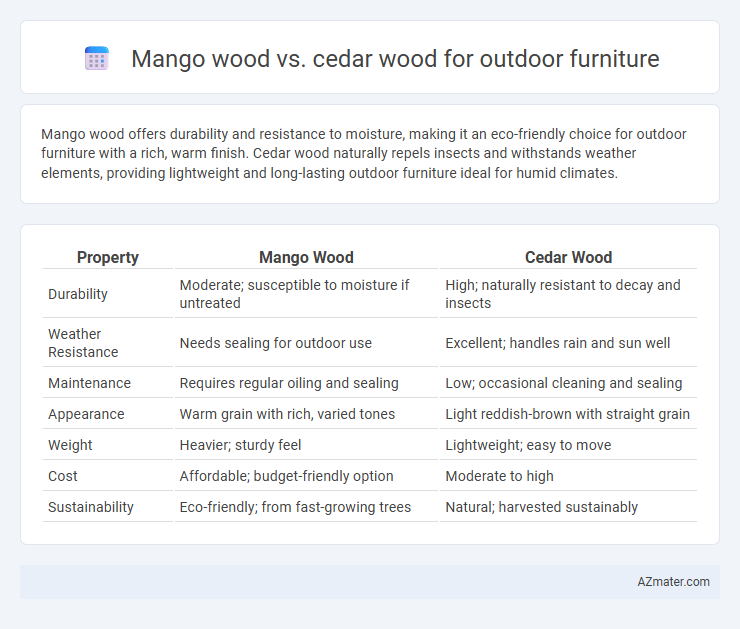Mango wood offers durability and resistance to moisture, making it an eco-friendly choice for outdoor furniture with a rich, warm finish. Cedar wood naturally repels insects and withstands weather elements, providing lightweight and long-lasting outdoor furniture ideal for humid climates.
Table of Comparison
| Property | Mango Wood | Cedar Wood |
|---|---|---|
| Durability | Moderate; susceptible to moisture if untreated | High; naturally resistant to decay and insects |
| Weather Resistance | Needs sealing for outdoor use | Excellent; handles rain and sun well |
| Maintenance | Requires regular oiling and sealing | Low; occasional cleaning and sealing |
| Appearance | Warm grain with rich, varied tones | Light reddish-brown with straight grain |
| Weight | Heavier; sturdy feel | Lightweight; easy to move |
| Cost | Affordable; budget-friendly option | Moderate to high |
| Sustainability | Eco-friendly; from fast-growing trees | Natural; harvested sustainably |
Introduction to Mango Wood and Cedar Wood
Mango wood, derived from the fast-growing mango tree, is a sustainable and dense hardwood prized for its durability and rich, warm tones, making it an excellent choice for outdoor furniture. Cedar wood, sourced from aromatic cedar trees, is naturally resistant to insects and decay, offering exceptional weather resistance and a distinctive reddish hue ideal for outdoor settings. Both woods provide unique benefits, with mango wood favored for its eco-friendliness and rich grain, while cedar is chosen for its natural protective oils and longevity in outdoor environments.
Key Characteristics of Mango Wood
Mango wood is a dense, durable hardwood with high resistance to water and pests, making it an excellent choice for outdoor furniture. Its coarse, open grain provides a distinctive aesthetic often complemented by natural color variations ranging from yellow to deep brown. The wood's sustainability and ability to withstand weather conditions without warping or cracking further enhance its appeal for outdoor use.
Key Characteristics of Cedar Wood
Cedar wood is prized for its natural resistance to decay, insect infestations, and moisture, making it highly durable for outdoor furniture. Its aromatic oils not only repel pests but also contribute to its distinctive reddish-brown color and fine grain texture. The wood's lightweight nature combined with its stability in varying weather conditions ensures long-lasting performance with minimal warping or cracking.
Durability of Mango Wood in Outdoor Settings
Mango wood exhibits impressive durability in outdoor furniture applications due to its dense grain and natural resistance to moisture, reducing the risk of warping and cracking. Unlike cedar, which contains natural oils that deter insects, mango wood requires proper sealing and maintenance to prevent weather damage and insect infestation. Its sustainability and strength make mango wood a viable, environmentally friendly choice for long-lasting outdoor furniture when adequately treated.
Durability of Cedar Wood in Outdoor Settings
Cedar wood exhibits exceptional durability for outdoor furniture due to its natural resistance to decay, insect damage, and moisture. Its high oil content acts as a protective barrier, enabling it to withstand harsh weather conditions and resist warping or cracking over time. This makes cedar an ideal choice for long-lasting outdoor pieces that require minimal maintenance and sustained structural integrity.
Weather Resistance: Mango Wood vs Cedar Wood
Mango wood offers moderate weather resistance for outdoor furniture, requiring regular sealing to prevent moisture absorption and cracking. Cedar wood inherently provides excellent weather resistance due to its natural oils and tight grain, making it highly durable against rot, insects, and moisture without extensive maintenance. Choosing cedar ensures longer-lasting outdoor furniture with minimal upkeep, while mango wood demands more protection to withstand harsh weather conditions.
Maintenance Requirements Comparison
Mango wood requires regular sealing and oiling to protect it from moisture and prevent cracking in outdoor furniture applications, while cedar wood naturally resists rot and insect damage due to its high natural oils, reducing the frequency of maintenance. Cedar's weather-resistant properties allow it to age gracefully with minimal intervention, typically needing only annual cleaning and occasional reapplication of protective finishes to maintain its appearance. Mango wood, although durable, demands more consistent upkeep to preserve its aesthetic and structural integrity in outdoor environments.
Aesthetic Appeal and Finishing Options
Mango wood offers a warm, rich grain with a smooth finish that enhances outdoor furniture's natural beauty and supports diverse staining and polishing options. Cedar wood features a distinctive reddish hue and aromatic qualities, providing natural resistance to insects and weather, while its coarse texture accommodates oils and stains for a rustic finish. Both woods allow for customizable aesthetic appeal, but mango wood typically delivers a more refined, elegant appearance, whereas cedar emphasizes durability with a rugged charm.
Sustainability and Environmental Impact
Mango wood, sourced from the fast-growing Mango tree, offers a sustainable alternative for outdoor furniture due to its renewable harvesting after fruit production declines, reducing deforestation pressures. Cedar wood, while naturally resistant to decay and insects, often involves slower growth cycles, resulting in higher environmental costs and potential depletion if not sourced from responsibly managed forests. Both woods provide durable options, but mango wood's rapid regeneration and utilization of otherwise discarded trees contribute to a lower carbon footprint and eco-friendly furniture solutions.
Cost Comparison and Value for Outdoor Furniture
Mango wood offers a cost-effective option for outdoor furniture, generally priced lower than cedar wood, making it attractive for budget-conscious buyers. While cedar wood commands a higher price due to its natural resistance to rot, insects, and weather conditions, its durability can translate into long-term value with less maintenance. Mango wood provides good strength and aesthetic appeal at a more affordable upfront cost, but may require additional treatment to match the longevity and resilience of cedar in outdoor environments.

Infographic: Mango wood vs Cedar wood for Outdoor Furniture
 azmater.com
azmater.com